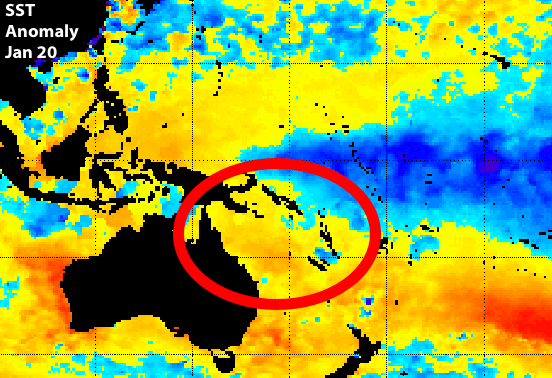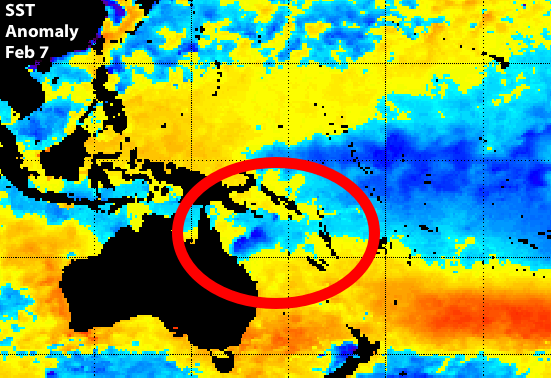Yasi Paints The Coral Sea Blue
 Here's something you might not know about Tropical Cyclones - as well as leaving a swathe of destruction on land, they also leave evidence of their path across the ocean.
Here's something you might not know about Tropical Cyclones - as well as leaving a swathe of destruction on land, they also leave evidence of their path across the ocean.
Check out the two charts to the right - they show the sea surface temperatures (SST) before and after the passage of Severe Tropical Cyclone (STC) Yasi in early February. For monitoring purposes, sea surface temperatures are most easily measured as 'anomalies', which is the difference between the current SST and the long-term average. Yellow and red colours indicate warmer-than-average sea surface temperatures, whilst blue and purple colours indicate cooler-than-average sea surface temperatures.
The blue track running north-east of Cairns in the second chart matches the path that STC Yasi took through the Coral Sea. The corresponding drop in SST was the result of STC Yasi absorbing energy from the Coral Sea as it strengthened. Tropical Cyclones feed off warm ocean waters, and with the extra available energy in the Coral Sea due to the higher than average sea surface temperatures, STC Yasi rapidly intensified into a Categorgy 5 system. Broad areas of high rainfall, and ocean mixing due to the large swell created by STC Yasi would have also contributed to a drop in sea surface temperatures.
 Before STC Yasi developed, SST anomalies were around 2 degrees higher than average in the Coral Sea, which can be seen in the first chart. This is related to the current La Nina pattern, whereby easterly trade-winds throughout the equatorial Pacific Ocean push warm tropical water into the Western Pacific Ocean and Coral Sea.
Before STC Yasi developed, SST anomalies were around 2 degrees higher than average in the Coral Sea, which can be seen in the first chart. This is related to the current La Nina pattern, whereby easterly trade-winds throughout the equatorial Pacific Ocean push warm tropical water into the Western Pacific Ocean and Coral Sea.
In the wake of STC Yasi, sea surface temperatures in the Coral Sea (in the path of STC Yasi) dropped to around 2 degrees below average. Only now are we starting to see the water temperatures slowly warm back up, almost two weeks after the event.
So even though Tropical Cyclones leave a visible and devastating signature on land, they also leave a mark on the ocean which when observed from a satellite makes for spectacular viewing. //Craig Brokensha

